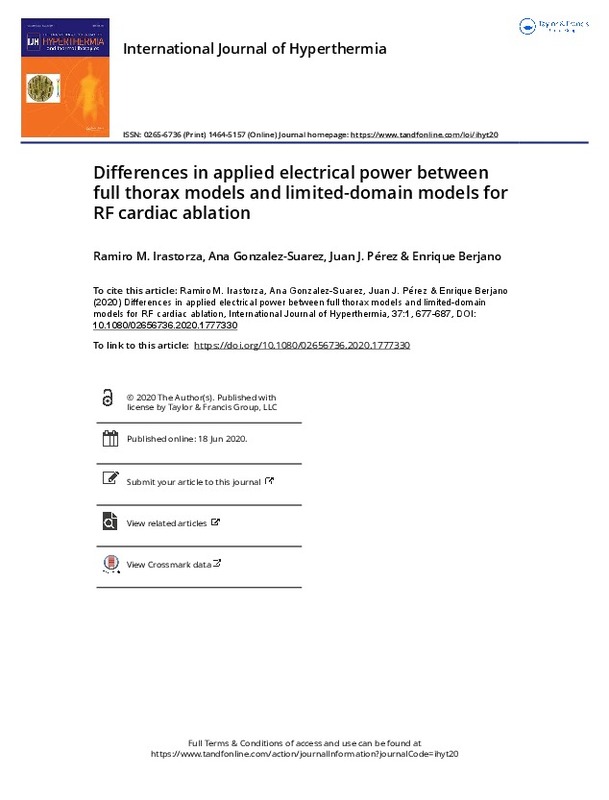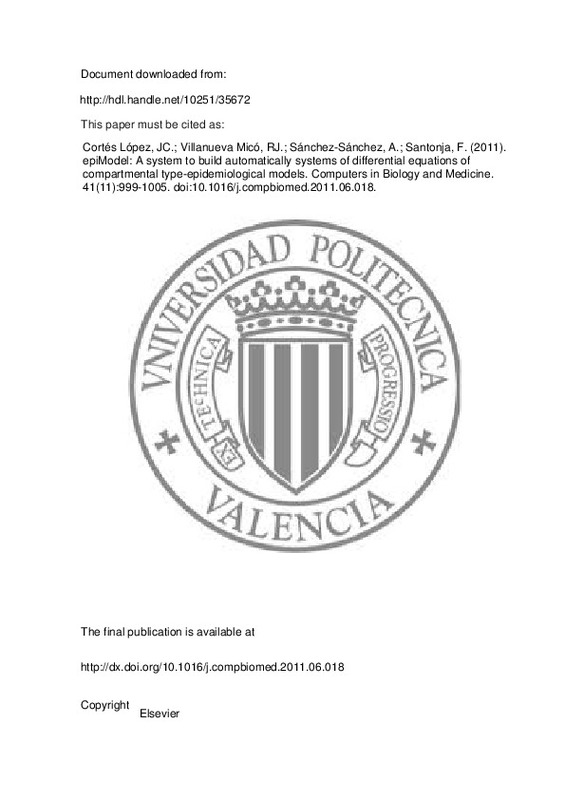Jain, M. K., & Wolf, P. D. (1999). Temperature-controlled and constant-power radio-frequency ablation: what affects lesion growth? IEEE Transactions on Biomedical Engineering, 46(12), 1405-1412. doi:10.1109/10.804568
Keller, M. W., Schuler, S., Wilhelms, M., Lenis, G., Seemann, G., Schmitt, C., … Luik, A. (2014). Characterization of Radiofrequency Ablation Lesion Development Based on Simulated and Measured Intracardiac Electrograms. IEEE Transactions on Biomedical Engineering, 61(9), 2467-2478. doi:10.1109/tbme.2014.2322515
LAU, M., HU, B., WERNETH, R., SHERMAN, M., ORAL, H., MORADY, F., & KRYSL, P. (2010). A Theoretical and Experimental Analysis of Radiofrequency Ablation with a Multielectrode, Phased, Duty-Cycled System. Pacing and Clinical Electrophysiology, 33(9), 1089-1100. doi:10.1111/j.1540-8159.2010.02801.x
[+]
Jain, M. K., & Wolf, P. D. (1999). Temperature-controlled and constant-power radio-frequency ablation: what affects lesion growth? IEEE Transactions on Biomedical Engineering, 46(12), 1405-1412. doi:10.1109/10.804568
Keller, M. W., Schuler, S., Wilhelms, M., Lenis, G., Seemann, G., Schmitt, C., … Luik, A. (2014). Characterization of Radiofrequency Ablation Lesion Development Based on Simulated and Measured Intracardiac Electrograms. IEEE Transactions on Biomedical Engineering, 61(9), 2467-2478. doi:10.1109/tbme.2014.2322515
LAU, M., HU, B., WERNETH, R., SHERMAN, M., ORAL, H., MORADY, F., & KRYSL, P. (2010). A Theoretical and Experimental Analysis of Radiofrequency Ablation with a Multielectrode, Phased, Duty-Cycled System. Pacing and Clinical Electrophysiology, 33(9), 1089-1100. doi:10.1111/j.1540-8159.2010.02801.x
Tian, Z., Nan, Q., Nie, X., Dong, T., & Wang, R. (2016). The comparison of lesion outline and temperature field determined by different ways in atrial radiofrequency ablation. BioMedical Engineering OnLine, 15(S2). doi:10.1186/s12938-016-0251-5
Jain, M. K., & Wolf, P. D. (2000). A Three-Dimensional Finite Element Model of Radiofrequency Ablation with Blood Flow and its Experimental Validation. Annals of Biomedical Engineering, 28(9), 1075-1084. doi:10.1114/1.1310219
Panescu, D., Whayne, J. G., Fleischman, S. D., Mirotznik, M. S., Swanson, D. K., & Webster, J. G. (1995). Three-dimensional finite element analysis of current density and temperature distributions during radio-frequency ablation. IEEE Transactions on Biomedical Engineering, 42(9), 879-890. doi:10.1109/10.412649
Gopalakrishnan, J. (2002). A Mathematical Model for Irrigated Epicardial Radiofrequency Ablation. Annals of Biomedical Engineering, 30(7), 884-893. doi:10.1114/1.1507845
JAIN, M. K., TOMASSONI, G., RILEY, R. E., & WOLF, P. D. (1998). Effect of Skin Electrode Location on Radiofrequency Ablation Lesions: An In Vivo and a Three-Dimensional Finite Element Study. Journal of Cardiovascular Electrophysiology, 9(12), 1325-1335. doi:10.1111/j.1540-8167.1998.tb00108.x
Tungjitkusolmun, S., Woo, E. J., Cao, H., Tsai, J. Z., Vorperian, V. R., & Webster, J. G. (2000). Thermal—electrical finite element modelling for radio frequency cardiac ablation: Effects of changes in myocardial properties. Medical & Biological Engineering & Computing, 38(5), 562-568. doi:10.1007/bf02345754
Tungjitkusolmun, S., Eung Je Woo, Hong Cao, Jang-Zern Tsai, Vorperian, V. R., & Webster, J. G. (2000). Finite element analyses of uniform current density electrodes for radio-frequency cardiac ablation. IEEE Transactions on Biomedical Engineering, 47(1), 32-40. doi:10.1109/10.817617
Tungjitkusolmun, S., Vorperian, V. R., Bhavaraju, N., Cao, H., Tsai, J.-Z., & Webster, J. G. (2001). Guidelines for predicting lesion size at common endocardial locations during radio-frequency ablation. IEEE Transactions on Biomedical Engineering, 48(2), 194-201. doi:10.1109/10.909640
Labonte, S. (1994). Numerical model for radio-frequency ablation of the endocardium and its experimental validation. IEEE Transactions on Biomedical Engineering, 41(2), 108-115. doi:10.1109/10.284921
Gallagher, N., Fear, E. C., Byrd, I. A., & Vigmond, E. J. (2013). Contact Geometry Affects Lesion Formation in Radio-Frequency Cardiac Catheter Ablation. PLoS ONE, 8(9), e73242. doi:10.1371/journal.pone.0073242
Hong Cao, Tungjitkusolmun, S., Young Bin Choy, Jang-Zern Tsai, Vorperian, V. R., & Webster, J. G. (2002). Using electrical impedance to predict catheter-endocardial contact during RF cardiac ablation. IEEE Transactions on Biomedical Engineering, 49(3), 247-253. doi:10.1109/10.983459
Shahidi, A. V., & Savard, P. (1994). A finite element model for radiofrequency ablation of the myocardium. IEEE Transactions on Biomedical Engineering, 41(10), 963-968. doi:10.1109/10.324528
Vassallo, F., Cunha, C., Serpa, E., Meigre, L. L., Carloni, H., Simoes, A., … Serpa, R. (2019). Comparison of high‐power short‐duration (HPSD) ablation of atrial fibrillation using a contact force‐sensing catheter and conventional technique: Initial results. Journal of Cardiovascular Electrophysiology, 30(10), 1877-1883. doi:10.1111/jce.14110
Leshem, E., Zilberman, I., Tschabrunn, C. M., Barkagan, M., Contreras-Valdes, F. M., Govari, A., & Anter, E. (2018). High-Power and Short-Duration Ablation for Pulmonary Vein Isolation. JACC: Clinical Electrophysiology, 4(4), 467-479. doi:10.1016/j.jacep.2017.11.018
Clark, K., Vendt, B., Smith, K., Freymann, J., Kirby, J., Koppel, P., … Prior, F. (2013). The Cancer Imaging Archive (TCIA): Maintaining and Operating a Public Information Repository. Journal of Digital Imaging, 26(6), 1045-1057. doi:10.1007/s10278-013-9622-7
null. (2016). null. Philosophy Study, 6(9). doi:10.17265/2159-5313/2016.09.003
González-Suárez, A., Gutierrez-Herrera, E., Berjano, E., Jimenez Lozano, J. N., & Franco, W. (2015). Thermal and elastic response of subcutaneous tissue with different fibrous septa architectures to RF heating: Numerical study. Lasers in Surgery and Medicine, 47(2), 183-195. doi:10.1002/lsm.22301
Fedorov, A., Beichel, R., Kalpathy-Cramer, J., Finet, J., Fillion-Robin, J.-C., Pujol, S., … Kikinis, R. (2012). 3D Slicer as an image computing platform for the Quantitative Imaging Network. Magnetic Resonance Imaging, 30(9), 1323-1341. doi:10.1016/j.mri.2012.05.001
Geuzaine, C., & Remacle, J.-F. (2009). Gmsh: A 3-D finite element mesh generator with built-in pre- and post-processing facilities. International Journal for Numerical Methods in Engineering, 79(11), 1309-1331. doi:10.1002/nme.2579
González-Suárez, A., Pérez, J. J., & Berjano, E. (2018). Should fluid dynamics be included in computer models of RF cardiac ablation by irrigated-tip electrodes? BioMedical Engineering OnLine, 17(1). doi:10.1186/s12938-018-0475-7
PÉREZ, J. J., D’AVILA, A., ARYANA, A., TRUJILLO, M., & BERJANO, E. (2016). Can Fat Deposition After Myocardial Infarction Alter the Performance of RF Catheter Ablation of Scar-Related Ventricular Tachycardia?: Results from a Computer Modeling Study. Journal of Cardiovascular Electrophysiology, 27(8), 947-952. doi:10.1111/jce.13006
BHASKARAN, A., BARRY, M. A., POULIOPOULOS, J., NALLIAH, C., QIAN, P., CHIK, W., … THIAGALINGAM, A. (2016). Circuit Impedance Could Be a Crucial Factor Influencing Radiofrequency Ablation Efficacy and Safety: A Myocardial Phantom Study of the Problem and Its Correction. Journal of Cardiovascular Electrophysiology, 27(3), 351-357. doi:10.1111/jce.12893
A. López Molina, J., J. Rivera, M., & Berjano, E. (2016). Electrical-thermal analytical modeling of monopolar RF thermal ablation of biological tissues: determining the circumstances under which tissue temperature reaches a steady state. Mathematical Biosciences and Engineering, 13(2), 281-301. doi:10.3934/mbe.2015003
Nsah, E., Berger, R., Rosenthal, L., Hui, R., Ramza, B., Jumrussirikul, P., … Calkins, H. (1998). Relation between impedance and electrode temperature during radiofrequency catheter ablation of accessory pathways and atrioventricular nodal reentrant tachycardia. American Heart Journal, 136(5), 844-851. doi:10.1016/s0002-8703(98)70130-9
Wen, Z.-C., Chen, S.-A., Chiang, C.-E., Tai, C.-T., Lee, S.-H., Chen, Y.-Z., … Chang, M.-S. (1996). Temperature and impedance monitoring during radiofrequency catheter ablation of slow AV node pathway in patients with atrioventricular node reentrant tachycardia. International Journal of Cardiology, 57(3), 257-263. doi:10.1016/s0167-5273(96)02833-1
Strickberger, S. A., Hummel, J., Gallagher, M., Hasse, C., Man, K. C., Williamson, B., … Langberg, J. J. (1995). Effect of accessory pathway location on the efficiency of heating during radiofrequency catheter ablation. American Heart Journal, 129(1), 54-58. doi:10.1016/0002-8703(95)90042-x
Irastorza, R. M., d’ Avila, A., & Berjano, E. (2017). Thermal latency adds to lesion depth after application of high-power short-duration radiofrequency energy: Results of a computer-modeling study. Journal of Cardiovascular Electrophysiology, 29(2), 322-327. doi:10.1111/jce.13363
Bourier, F., Duchateau, J., Vlachos, K., Lam, A., Martin, C. A., Takigawa, M., … Jais, P. (2018). High‐power short‐duration versus standard radiofrequency ablation: Insights on lesion metrics. Journal of Cardiovascular Electrophysiology, 29(11), 1570-1575. doi:10.1111/jce.13724
Schutt, D., Berjano, E. J., & Haemmerich, D. (2009). Effect of electrode thermal conductivity in cardiac radiofrequency catheter ablation: A computational modeling study. International Journal of Hyperthermia, 25(2), 99-107. doi:10.1080/02656730802563051
[-]











